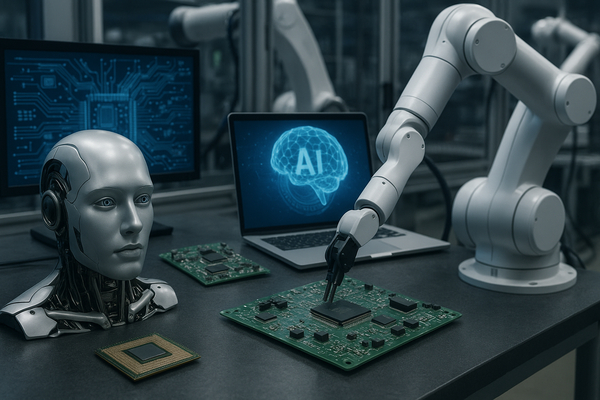
Apple pushes deeper into AI and robotics. The company (NASDAQ:AAPL) faces a flurry of developments that matter now: a public meeting over trade tensions with China, reports it is building robots, new Mac and Vision Pro product updates, exec departures and possible AI-focused M&A. In the short term, these items are reshaping market sentiment and supply choices. Over the long term, they accelerate on-device AI, diversify manufacturing and sharpen competition for data center and chip capacity. Globally, moves influence US-China relations, spur demand in Asia for semiconductors and ripple through Europe and emerging markets as cloud and device strategies adjust.
Apple’s strategic moves: robotics, devices, talent and China talks
Apple (NASDAQ:AAPL) has been unusually active across product, people and policy fronts. China’s Commerce Minister Wang Wentao publicly met Tim Cook and blamed “intensive U.S. restrictive measures” for recent trade tensions. That interaction matters now because it frames an immediate diplomatic context for Apple’s supply choices and market access in China.
Reports that Apple is preparing to enter robotics pushed headlines. Analysts framed robotics as an on-device AI extension rather than a pure hardware bet; Morgan Stanley called it “one small step on your desk. One giant leap for AI.” At the same time Apple rolled out M5 Macs and Vision Pro updates, and a MacBook Pro variant that reportedly reaches up to 24 hours of battery life.
In personnel and M&A signals, Apple lost an AI-driven web search lead to Meta (NASDAQ:META) and is reported to be in talks to acquire Prompt AI to boost on-device intelligence. Meanwhile, product roadmaps include a touch-screen MacBook slated for late 2026 or early 2027 and a rumored foldable phone that some analysts say will not materially move revenue in the near term. Together these moves suggest Apple is prioritizing on-device AI, vertical integration and developer tools while managing geopolitical pressure on supply chains.
AI infrastructure and the chip cycle: TSMC, Nvidia and capital intensity
Semiconductor demand is currently a central driver of market momentum. Taiwan Semiconductor Manufacturing Company (NYSE:TSM) reported a near 40% year-on-year jump in net profit for the July-September quarter, a result that boosted chip stocks and helped lift US indexes in the immediate session. TSMC’s strong results and a rosy outlook for AI compute demand are accelerating orders for advanced packaging and wafer capacity.
That dynamic is also lifting firms across the AI stack. Nvidia (NASDAQ:NVDA) saw positive spillovers after TSMC’s update. Broadcom (NASDAQ:AVGO) rallied on large AI-related deals. At the infrastructure level, Citi analysts estimated OpenAI’s capital spending related to chip deals could reach roughly $1.3 trillion by 2030, highlighting the scale of compute buildout required to sustain current generative AI development.
Cloud and software names are responding too. Microsoft (NASDAQ:MSFT) is under investor focus for Azure and its OpenAI partnership, while also moving a majority of product manufacturing out of China by 2026 and rolling AI-first updates into Windows 11 to position PCs as AI endpoints. In addition, major cloud providers are adjusting supply chains and data center sourcing to balance resilience and cost.
Market implications, risks and practical takeaways for corporates and policymakers
In the near term, earnings beats and supply signals are driving market moves. Investors quickly priced TSMC’s beat and upbeat outlook into chip and cloud names, lifting indexes that then staged mixed intraday performance as regional bank worries and trade rhetoric surfaced. Over the longer term, three tensions will shape the next phase:
- Capacity squeeze for advanced node wafers and high-bandwidth memory as AI demand climbs.
- Geopolitical pressure that forces Western tech firms to reconfigure Chinese supply exposure and local partnerships.
- Talent and product flows as executives move between Big Tech and rival platforms, and as on-device AI investments shift development patterns.
Practical scenarios to watch include incremental increases in data center commitments from hyperscalers, stepped-up procurement for HBM and GPUs, and further corporate announcements about manufacturing localization outside China.
Key takeaways
- Apple’s push into robotics and on-device AI is simultaneous with product refreshes and talent shifts, making its near-term moves strategically significant.
- TSMC’s ~39% year-on-year profit jump underscores how AI compute demand is driving semiconductor revenue and market sentiment.
- OpenAI-scale capex needs — cited near $1.3 trillion by 2030 — signal persistent pressure on chip and power infrastructure.
- Microsoft’s manufacturing shift out of China by 2026 and Windows 11 AI updates highlight how cloud, device and supply strategies are converging.
- Policymakers and corporates should expect supply reconfiguration, increased data center commitments, and continued competition for advanced memory and accelerators.
These developments are informational. They show how product strategy, chip economics and geopolitics are interacting now. Watch near-term earnings, capital commitments from cloud providers and firm-level supply moves for the clearest signals of how the next phase will take shape.












